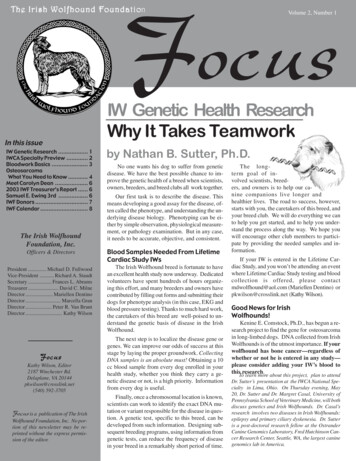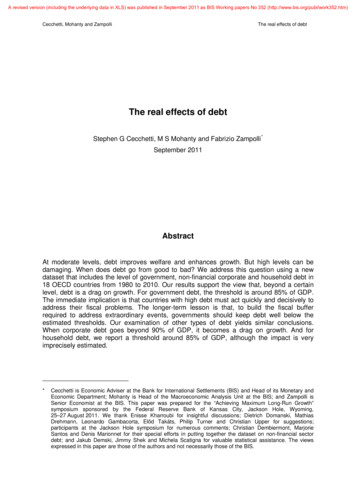
Transcription
The Irish Wolfhound FoundatioFoundationVolume 2, Number 1FocusIn this issueIW Genetic Research . 1IWCA Specialty Preview . 2Bloodwork Basics . 3OsteosarcomaWhat You Need to Know . 4Meet Carolyn Dean . 62003 IWF Treasurer’s Report . 6Samuel E. Ewing 3rd . 6IWF Donors . 7IWF Calendar . 8The Irish WolfhoundFoundation, Inc.Officers & DirectorsPresident . Michael D. FullwoodVice-President . Richard A. StaudtSecretary . Frances L. AbramsTreasurer . David C. MilneDirector . Mariellen DentinoDirector . Marcella GranDirector . Peter R. Van BruntDirector . Kathy WilsonFocusKathy Wilson, Editor2187 Winchester Rd.Delaplane, VA 20144pkwilson@crosslink.net(540) 592-3705Focus is a publication of The IrishWolfhound Foundation, Inc. No portion of this newsletter may be reprinted without the express permission of the editor.IW Genetic Health ResearchWhy It Takes Teamworkby Nathan B. Sutter, Ph.D.No one wants his dog to suffer from geneticdisease. We have the best possible chance to improve the genetic health of a breed when scientists,owners, breeders, and breed clubs all work together.Our first task is to describe the disease. Thismeans developing a good assay for the disease, often called the phenotype, and understanding the underlying disease biology. Phenotyping can be either by simple observation, physiological measurement, or pathology examination. But in any case,it needs to be accurate, objective, and consistent.Blood Samples Needed From LifetimeCardiac Study IWsThe Irish Wolfhound breed is fortunate to havean excellent health study now underway. Dedicatedvolunteers have spent hundreds of hours organizing this effort, and many breeders and owners havecontributed by filling out forms and submitting theirdogs for phenotype analysis (in this case, EKG andblood pressure testing). Thanks to much hard work,the caretakers of this breed are well-poised to understand the genetic basis of disease in the IrishWolfhound.The next step is to localize the disease gene orgenes. We can improve our odds of success at thisstage by laying the proper groundwork. CollectingDNA samples is an absolute must! Obtaining a 10cc blood sample from every dog enrolled in yourhealth study, whether you think they carry a genetic disease or not, is a high priority. Informationfrom every dog is useful.Finally, once a chromosomal location is known,scientists can work to identify the exact DNA mutation or variant responsible for the disease in question. A genetic test, specific to this breed, can bedeveloped from such information. Designing subsequent breeding programs, using information fromgenetic tests, can reduce the frequency of diseasein your breed in a remarkably short period of time.The longterm goal of involved scientists, breeders, and owners is to help our canine companions live longer andhealthier lives. The road to success, however,starts with you, the caretakers of this breed, andyour breed club. We will do everything we canto help you get started, and to help you understand the process along the way. We hope youwill encourage other club members to participate by providing the needed samples and information.If your IW is entered in the Lifetime Cardiac Study, and you won’t be attending an eventwhere Lifetime Cardiac Study testing and bloodcollection is offered, please contactmdwolfhound@aol.com (Mariellen Dentino) orpkwilson@crosslink.net (Kathy Wilson).Good News for IrishWolfhounds!Kenine E. Comstock, Ph.D., has begun a research project to find the gene for osteosarcomain long-limbed dogs. DNA collected from IrishWolfhounds is of the utmost importance. If yourwolfhound has bone cancer—regardless ofwhether or not he is entered in any study—please consider adding your IW’s blood tothis research.To learn more about this project, plan to attendDr. Sutter’s presentation at the IWCA National Specialty in Lima, Ohio. On Thursday evening, May20, Dr. Sutter and Dr. Margret Casal, University ofPennsylvania School of Veterinary Medicine, will bothdiscuss genetics and Irish Wolfhounds. Dr. Casal’sresearch involves two diseases in Irish Wolfhounds:epilepsy and primary ciliary dyskenesia. Dr. Sutteris a post-doctoral research fellow at the OstranderCanine Genomics Laboratory, Fred Hutchinson Cancer Research Center, Seattle, WA, the largest caninegenomics lab in America.
IWFSpeakers & Eventsat the2004 IWCA SpecialtySeminars Clinics Testing Dr. Pamela J. Grasso got her first wolfhound,Brae, when she graduated from vet school, and she hashad them ever since. Pam works with Potomac ValleyIW Rescue, and sees many IWs in her small animalpractice. In addition to her DVM, Pam has an MS inveterinary science, and is certified in Acupuncture andChinese Herbal Medicine. She will speak on Wednesdayevening, in a program sponsored jointly by IWCA andIWF.Dr. R. Scott Dove’s presentation on Wewdnesdayevening will focus on chiropractic therapy for sighthounds.Dr. Dove is a long-time Scottish Deerhound breeder andan avid foxhunter. He specializes in canine reproductionin addition to chiropractic and acupuncture therapy in hissmall animal practice. He has spoken to many breed andall-breed clubs.Dr. Margret Casal is Assistant Professor ofMedical Genetics at the Univeristy of Pennsylvania. Inaddition to her VMD, she holds a PhD in pathology andgenetics. Her areas of special interest are genetic skindiseases and epilepsy and rhinitis in the Irish Wolfhound.Dr. Casal has worked with the IW Seizure Study sinceits inception. She will speak on Thursday evening.Dr. Nathan B. Sutter is a post-doctoral researchfellow at the Ostrander Canine Genomics Laboratory atthe Fred Hutchinson Cancer Research Center in Seattle,WA. Dr. Sutter will speak on Thursday evening, andhelp with DNA collection for IW health research on Thursday and Friday. Dr. Sutter spoke at IWADV in October,2003.Dr. Anne Gemensky-Metzler conducted ourfirst IW CERF Clinic in Springfield, Ohio, last May. AnAssistant Professor of Veterinary Ophthalmology at OhioState University, Dr. Gemenmsky-Metzler will once againexamine the eyes of our hounds in Lima. The CERFClinic will begin at 2:00 on Friday afternoon on the showgrounds. Reserve a time by signing up at the Health Tent.2Tuesday, May 18î THE IWF GIFT SHOP opens its doors at theAnnual Board Welcome Reception, HeadquartersMotel (Best Western Lima).Wednesday, May 19î TESTING on the ShowgroundsLifetime Cardiac Study EKG & BP TestingOn the spot urinalyses for LCS IWsDNA Collection for IW Genetic Reserarchî IWF GIFT SHOP opens on the showgroundsî SEMINAR at the Headquarters MotelComplementary Therapies for IWsDr Pamela J. Grasso and Dr. Scott DoveSponsored jointly by IWCA & IWFThursday, May 20î SEMINAR at the Headquaters MotelThe Future of IW Genetic Research (Dr. Nathan B.Sutter) and Seizures and PCD in the IW (Dr. MargretCasal). Free pizza and Cash Bar.î TESTING continues daily at the show siteî IWF GIFT SHOP is open for business at the show!Friday, May 21ÎCERF CLINIC at the ShowgroundsDr. Anne Gemensky-Metzler, DAVCOî TESTING continues at the Health TentÎ ANNUAL IWF AUCTION at the HeadquartersMotelSaturday, May 22Î FINAL DAY OF TESTINGCut-off date for Lifetime Cardiac Study entryÎ RESEARCH RAFFLE DRAWING followingthe Judges Dinner
Bloodwork BasicsA Reference GuideYour vet can check the complete blood count (CBC) , analyze bloodchemistry to assess organ function, and check titers to see if diseasefighting antigens are present—all from one sample of your IW’s blood.Many factors, such as drug interaction and fasting, can affect results;interpretation takes expertise.COMPLETE BLOOD COUNTThe CBC evaluates three types of cells in the blood: red, white, andplatelets. Blood cells are manufactured in the bone marrow, and eachcell type performs a specific function which is critical to the overallhealth of the animal.HEMATOCRIT gives the proportion of the blood, by volume, whichconsists of red blood cells. A low hematocrit (anemia) may have manycauses. High hematocrits are seen in many sighthounds, and in animalsliving at high altitudes, and also in dehydration.HEMOGLOBIN is the iron-rich protein in red blood cells. Sinceoxygen travels through the bloodstream bound to haemoglobin, this measurement indicates how much oxygen the blood can carry throughoutthe body.WBC are the white blood cells, or leukocytes which fight infectionin the body, and transport antibodies to sites of infection. An abnormalwhite cell count can indicate infection, inflammation, or other stress.Normal WBC values for Irish Wolfhounds are frequently at the very lowend of normal range.RBC or Red Blood Cell Count. In addition to carrying oxygen tothe tissues, red blood cells also transfer carbon dioxide to the lungs.MCV or Mean Corpuscular Volume. This value gives the size ofthe red blood cells, by measuring the volume of a single red cell.MCH or Mean Corpuscular Hemoglobin. This measures the average weight of hemoglobin in the red blood cell.MCHC is the mean corpuscular hemoglobin concentration. This testuses hemoglobin and hematocrit for calculation, rather than the red bloodcell. MCV, MCH, and MCHC are most useful in assessing anemia, andin choosing therapy to treat it.PLATELETS are also known as thrombocytes, and are vital to coagulation. Decreased levels may mean an immune system failure, ordeficiency of B12 or folic acid. Increased levels are seen in dehydration.The DIFFERENTIAL count measures the numbers of the differenttypes of white cells in the bloodstream. Each of these five cell types hasa specific role to play.NEUTROPHILS are the body’s soldiers, defending against invaders. They are the body’s chief defense against antigens and infection.Bands are immature neutrophilsEOSINOPHILS and BASOPHILS in the blood may be increasedin allergic conditions, or in infestations with ecto/endo parasites. (EOSand BASOS).LYMPHOCYTES produce antibodies, but most circulating in thebloodstream either attack invaders or coordinate the attack of antibodies. They are especially important in fighting viral infections.MONOCYTES are the body’s second line of defense against infection. Elevated levels are seen in tissue breakdown, chronic infection,and certain types of cancer.BLOOD CHEMISTRYGLUCOSE is the main source of energy. It is regulated by insulinproduced in the pancreas, and other hormones and enzymesKIDNEY FUNCTIONCREATININE AND B.U.N. are normally removed by the kidneysand excreted in urine. Elevated levels may reflect heart or kidneydisease, among other things. Urea Nitrogen (B.U.N.) is the end wasteproduct of protein metabolism. Creatinine is a waste product of musclemetabolism.PROTEINTOTAL PROTEIN Proteins are the most numerous compounds inserum. Elevated levels can indicate, among other things, liver disease,lupus, or chronic infection.ALBUMIN accounts for over 50% of serum protein, and it is manufactured by the liver.GLOBULIN is important in immunologic responses, especially itsgamma component. Higher levels in the bloodstream can be fromchronic infection, whereas low levels results from immune compromise or liver or kidney disease.LIVER FUNCTIONALT (Alanine aminotransferase), was formerly called SGPT. It isan enzyme found primarily in the liver, and its level is useful in diagnosing liver damageAST (Aspartate aminotransferase) is found primarily in the liver.Increased levels are found when there is severe diffuse hepatic insult,and also when there is tissue damage, kidney infection, or other problems. When levels are decreased, along with increased cholesterol levels, it is seen in cases of congested liver disease.ALKALINE PHOSPHATASE This enzyme is produced in thecells of the bone and liver, and elevated levels can be a marker fortumors.BILIRUBIN is a by-product of the breakdown of hemoglobin. It isa good indication of the liver’s function.GGTP (Gamma-Glutamyltransferase, or Gamma-GlutamylTranspeptidase). Elevated levels are found in liver disease and bileduct obstruction.CHOLESTEROL is a critical fat that is involved in many important cell functions. Dogs, unlike humans, do not really suffer from theartherosclerosis associated with consuming high-fat foods.PANCREASLIPASE is a pancreas-specific enzyme, and, when elevated levelsare found in the blood, it is an indication that damage to the pancreashas occurred.AMYLASE is manufactured in the pancreas and in the digestivetract, and, along with lipase, can indicate damage to the pancreas. However, the pancreas can be very inflamed without a rise in either value.ELECTROLYTESCALCIUM All cells require calcium to function. It is crucial inbone structure and neuromuscular activity. Calcium deficiency in thebody fluids causes hyperexcitable nerves and muscles.POTASSIUM is the major positive ion within cells. AbnormallyContinued on page 63
O steosarcoma What You Need to Knowby Kathy WilsonWhy you need to know now!PrognosisOsteosarcoma is the type of bone cancerthat kills over 25% of all Irish Wolfhounds.It is an extremely aggressive and malignanttumor. Because of the swift progress of thisdisease, time is of the essence. New insightsinto the biology of tumor growth, along withan expanding arsenal of drugs available fortreatment, have made it possible to extendquality life for our hounds. Early diagnosis isthe key to capitalizing on the effectivenessof these treatments.Osteosarcoma and hemangiosarcomashare a predilection for older, large and giantbreeds, but dogs of any age and size can—and do—suffer from it. A dog who weighsover 80 pounds is about 60 times more likelyto develop osteosarcoma than a smaller dog.There are other malignancies found in bone,but this tumor is by far the most commontype of primary bone tumor in dogs. Between8,000 and 10,000 dogs in the US willdevelop it this year Our breed is not alone.This article was written to help yourecognize the symptoms of this disease, andto prepare you and your veterinarian to dealwith it as expeditiously as possible.In humans, most osteosarcomas occur inadolescents, especially those undergoinggrowth spurts. It is likely that the rapidlydividing cells found in the growth plates(both human and canine) are at a greater riskof genetic mutation.DiagnosisThe classic scenario is a wolfhound whohas lameness and swelling near a joint onone of his legs. When first brought to thevet, the IW was lame, but no swelling wasdetected. Often, rest and a little Rimadylbring temporary improvement, but thelameness recurs, and this time the hardswelling is noticed. Radiographs (x-rays) ofthe affected limb go a long way toward apositive diagnosisMost malignancies occur in the majorweight-bearing bones of either the front orhind legs, with about a 60%/40% split frontto rear. The most common site is the distalradius (the foreleg near the pastern, or‘wrist’), with the proximal humerus (upperarm near the shoulder joint) running a closesecond. The old adage, “away from theelbow, toward the knee” is accurate in thefront, but in the rear, tumors can occur inboth the proximal and distal femur (thighbone, close to and away from the knee) aswell as the distal tibia (shin bone, near therear pastern, or hock joint). Osteosarcoma isnot found mid-shaft, but at the ends of thebone, in the metaphyseal area where growthoccurs (growth plates).Investigate lameness promptly. Don’t beafraid to be proactive! Ask your veterinarianto x-ray your wolfhound if he is limping andyou can’t recall an injury. By all means,investigate all options for treatment, but beaware that in most cases, survival timefollowing diagnosis is measured in days andweeks, not months and years. Treatmentbegun immediately has a better chance ofcontrolling this disease.Blood chemistry is often performed at thetime of diagnosis, and alkaline phosphataselevels are indicattive of prognosis. Veryhigh activity (i.e., two to four times normal)of alkaline phosphatase is a sign of poorprognosis. The tumor’s location is alsoprognostic, with tumors on the proximalhumerus faring worst. Young dogs with osteousually have very malignant tumors, with apoor prognosis. Also, dogs who show overtsigns of metastases at time of diagnosis farepoorly.MetastasesCancer cells which break away andspread to other areas of the body are calledmetastases. Micrometastases have alreadyspread in about 90% of dogs by the time ofinitial diagnosis. However, only about 10 %of these dogs will have metastases largeenough to be found at the time of diagnosis.Bone cancer does not spread across the joint,but rather spreads through the blood streamor the lymph system. Common sites formetastases are the lungs and other longbones, but metastases can be found anywhere. Palpation for skeletal and extraskeletal nodules and additional radiographsof the chest can aid in diagnosing metastases.Chest films should include two lateralthoracic views as well as a vetrodorsal view.Bone scans (scintigraphy) are also extremelyuseful in picking up metastases to the otherlimbs, but are available only at veterinaryteaching hospitals and specialty referralcenters, and require an overnight stay.Biopsy is not routinely recommended,because it carries additional risk of fractureto the already-weakened bone. In some cases,though, it may be essential to rule out fungaldisease, which has a similar appearance onfilm.Tumor TypeThere are several subtypes of tumors,but, in general, osteosarcomas can bedescribed as osteoblastic, osteolytic, ormixed (a combination of both cell types). Inlytic (osteolytic) tumors, the destructiveprocesses outstrip the laying down of newbone. Osteoblastic tumors stimulate production of excessive, unsound new bone matrix.It is believed that most tumors start outas lytic, but progress to mixed. Tumor type,as well as staging (extent of the disease),account for much the variation encounteredin response to treatment.TRADITIONAL PAIN MANAGEMENTOsteosarcoma is one of the most painfultypes of cancer; most dogs are euthanizedbecause of it. The pain increases as thetumor grows and destroys the bone from theinside out., Traditional methods of painrelief include use of analgesics (painrelieving durgs), radiation of the primarytumor site, or amputation/limb salvagesurgery. Acupuncture may also provide somerelief.NSAIDS and SteroidsNSAIDs (non-steroidal anti-inflammatorydrugs) available for veterinary use, includeRimadyl, Deramaxx, and Feldene, as well asaspirin. Acetaminophen is sometimes used indogs, but probably will not give adequatepain relief. NSAIDs are usually welltolerated, but a proton-pump inhibitor, suchas Prilosec, should be added to lessen thepossibility of GI tract problems, which are aprimary side effect. Steroids such as prednisone are also excellent for reducing theinflamation and easing pain, The dose ofsteroids can be increased as the tumor growsand pain increases.OpioidsWhen other pain medications no longerprovide adequate relief, opioids should beadded. Opioids include morphine, codeine,fentanyl, hydromorphone, and oxycodone.Combined with NSAIDs, they can make yourwolfhound more comfortable. Also, there aresome new options, such as Tramadol, areavailable.
Radiation TherapyRadiation in canine osteosarcoma is usedfor pain palliation. About 70% of the dogstreated will have significant pain relief.Usually, four treatments are given at oneweek intervals. This radiation is usuallydelivered by a machine that shoots highenergy x-ray beams to the tumor in a processcalled external beam radiation. However,radiation can increase the risk of fracture indogs with lytic tumors.Amputation /Limb SparingSurgeryAmputation of the affected leg willcertainly relieve the pain of the primarytumor, as will limb-salvage surgery, whichremoves the primary tumor but attempts tosave the affected leg by resection, or byimplanting a bone har
in addition to chiropractic and acupuncture therapy in his small animal practice. He has spoken to many breed and all-breed clubs. Dr. Pamela J. Grasso got her first wolfhound, Brae, when she graduated from vet school, and she has had them ever since. Pam works with Potomac Valley I











